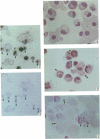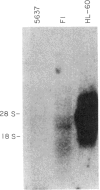Abstract
The observation that mast cell products and cachectin/tumour necrosis factor (TNF) mediate similar responses suggested an investigation of cultured human basophil/mast cells for production of TNF. Using in situ hybridization and the avidin biotin-complex (ABC) immunoperoxidase method, we have demonstrated the presence of TNF mRNA in the cytoplasm and TNF protein in the granules of individual human basophil/mast cells. The production of TNF by these cells could explain many of their reported functions.
Full text
PDF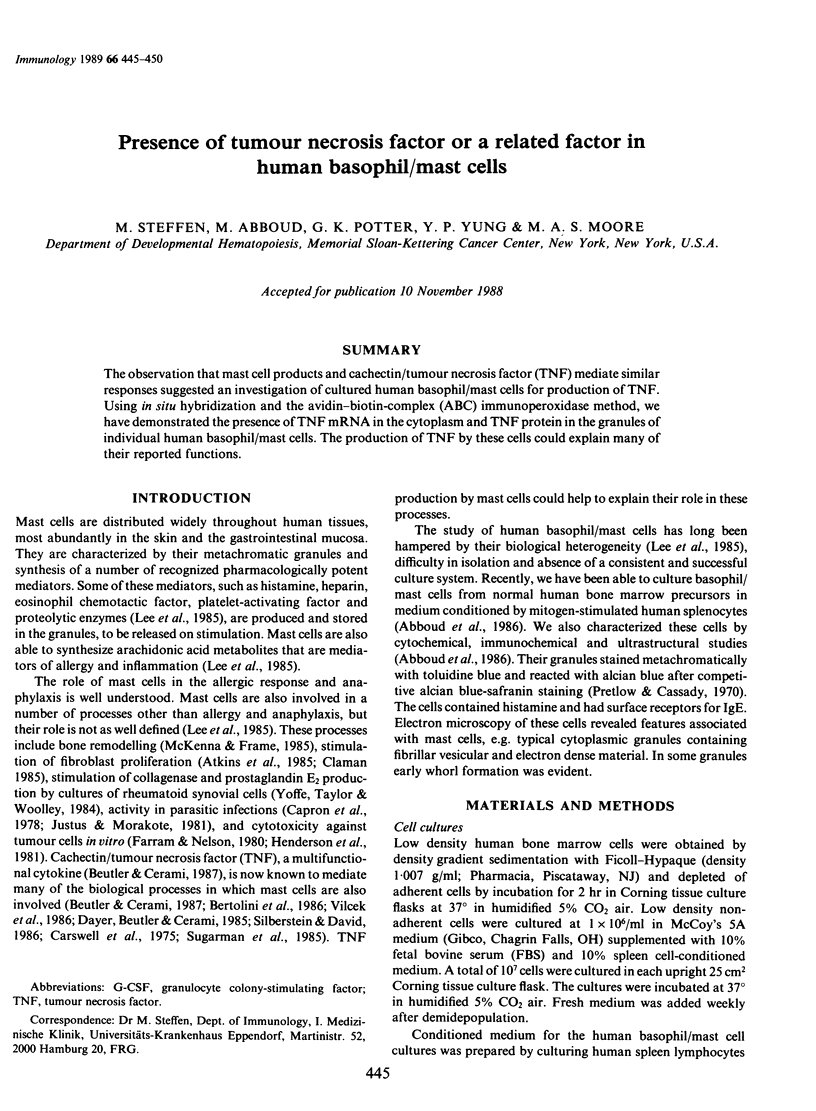
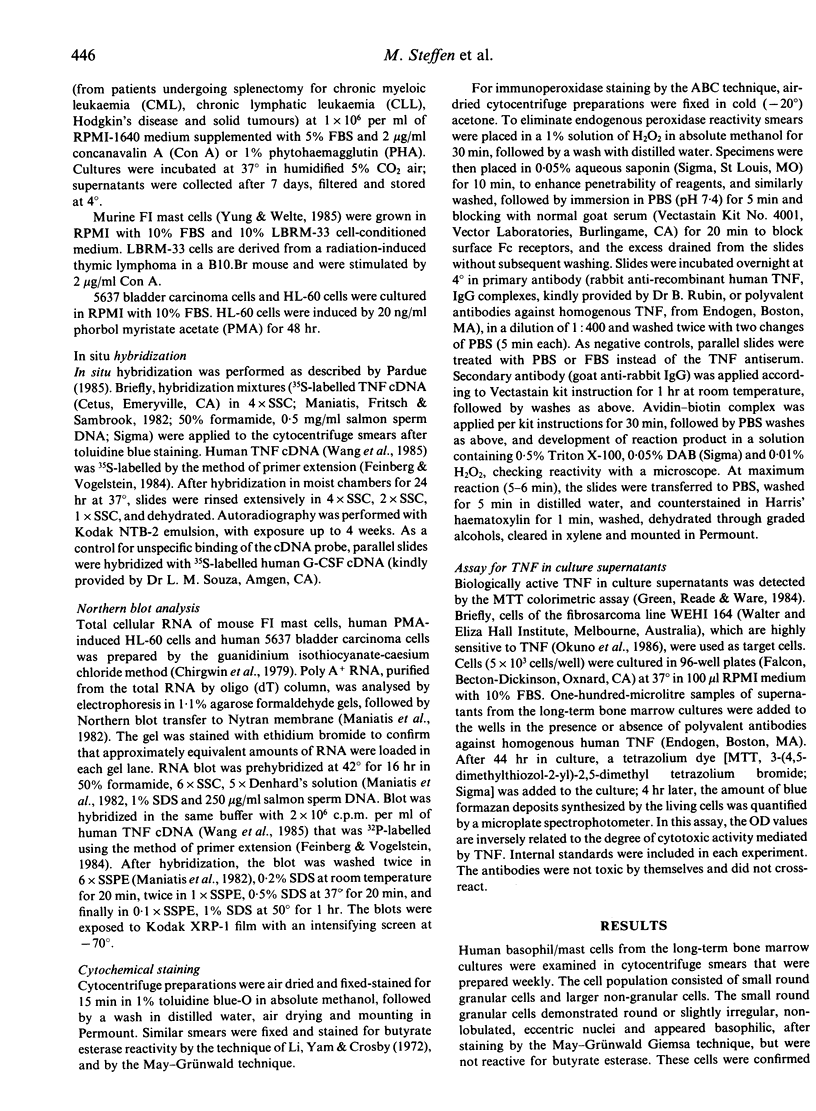
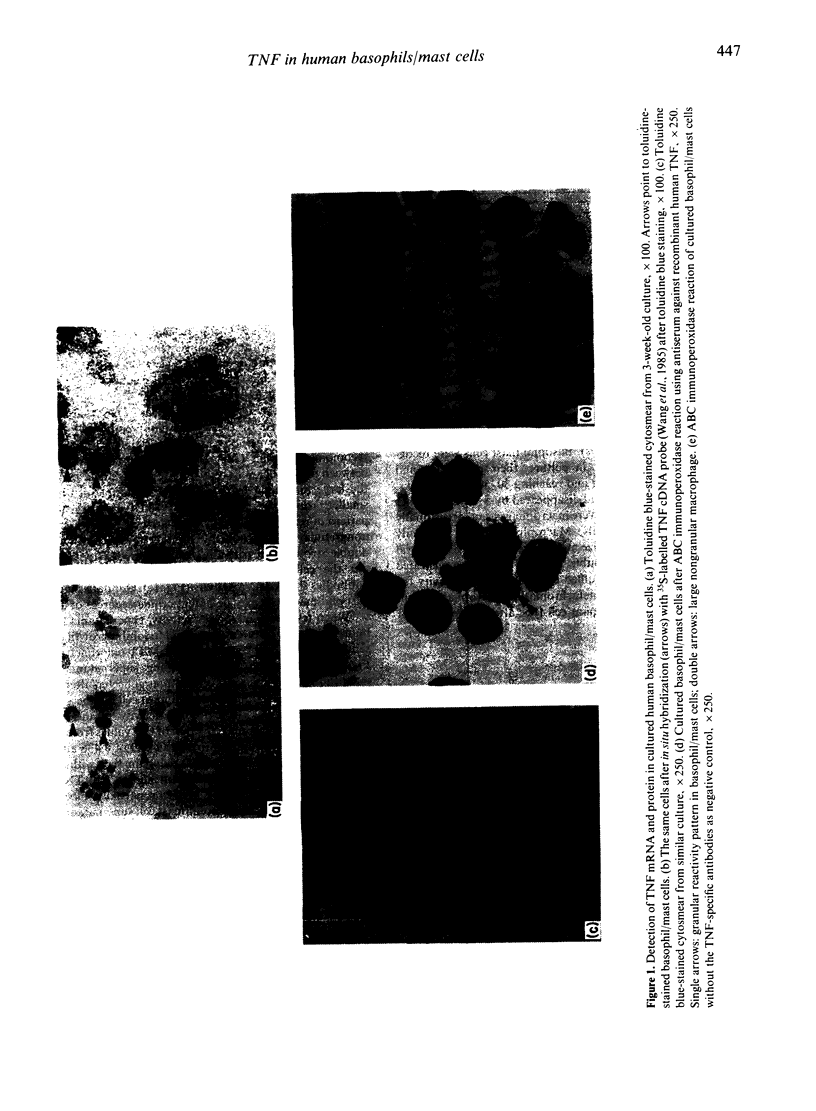
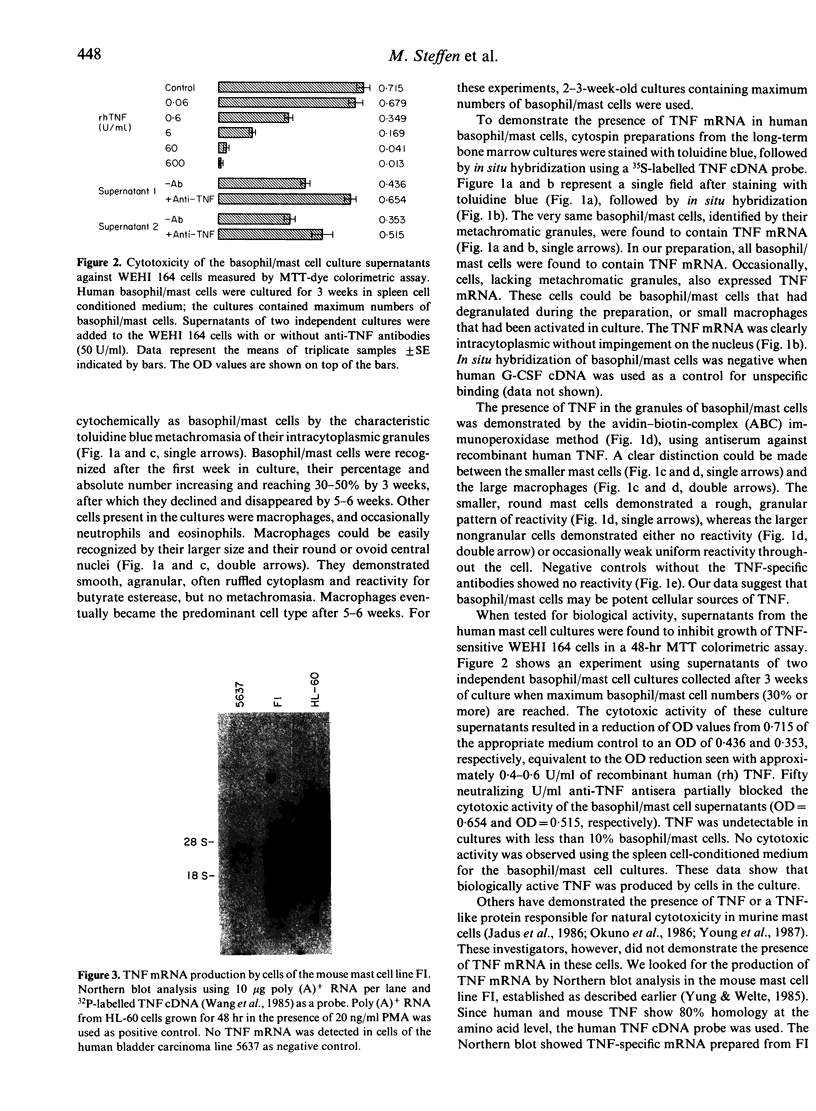
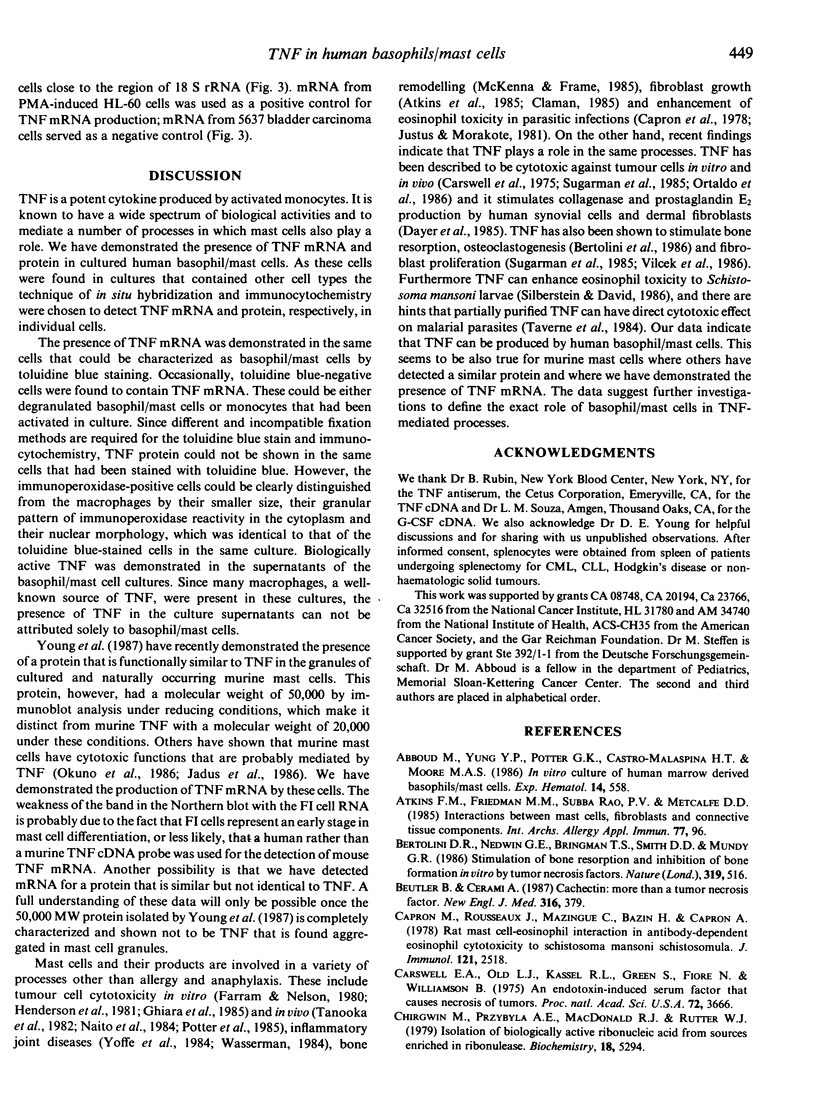
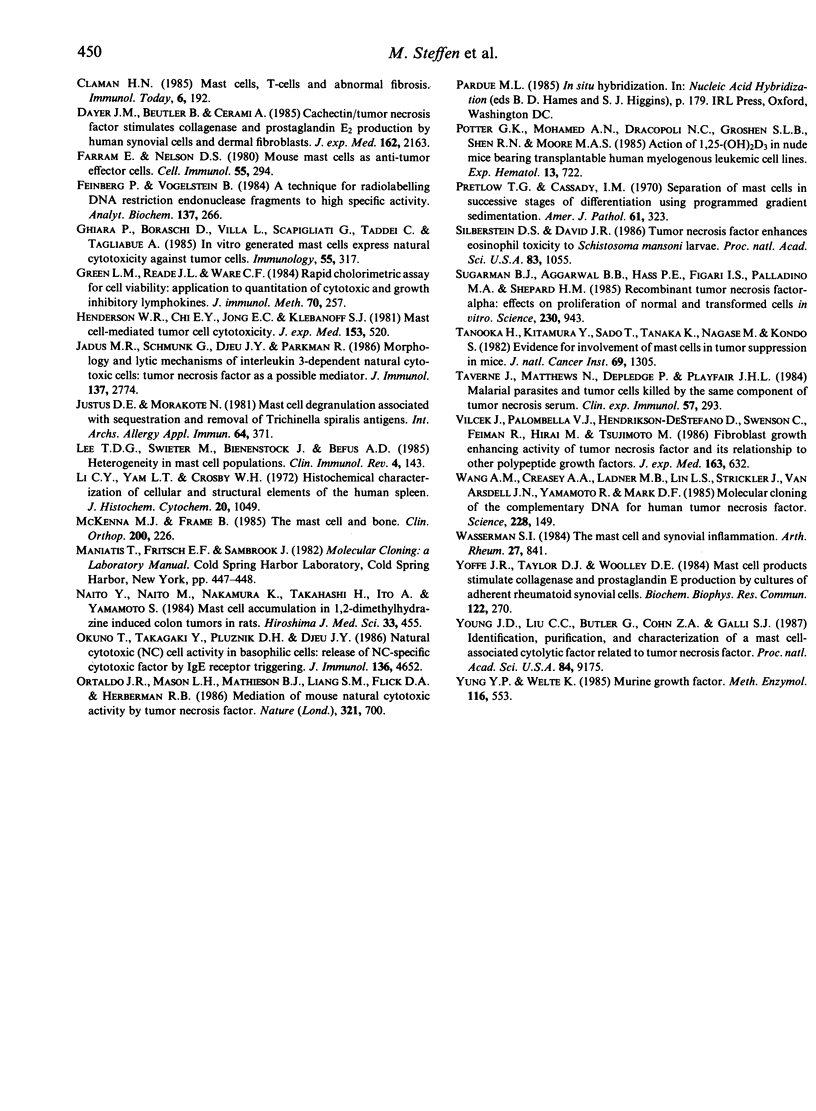
Images in this article
Selected References
These references are in PubMed. This may not be the complete list of references from this article.
- Bertolini D. R., Nedwin G. E., Bringman T. S., Smith D. D., Mundy G. R. Stimulation of bone resorption and inhibition of bone formation in vitro by human tumour necrosis factors. Nature. 1986 Feb 6;319(6053):516–518. doi: 10.1038/319516a0. [DOI] [PubMed] [Google Scholar]
- Beutler B., Cerami A. Cachectin: more than a tumor necrosis factor. N Engl J Med. 1987 Feb 12;316(7):379–385. doi: 10.1056/NEJM198702123160705. [DOI] [PubMed] [Google Scholar]
- Capron M., Rousseaux J., Mazingue C., Bazin H., Capron A. Rat mast cell-eosinophil interaction in antibody-dependent eosinophil cytotoxicity to Schistosoma mansoni schistosomula. J Immunol. 1978 Dec;121(6):2518–2525. [PubMed] [Google Scholar]
- Carswell E. A., Old L. J., Kassel R. L., Green S., Fiore N., Williamson B. An endotoxin-induced serum factor that causes necrosis of tumors. Proc Natl Acad Sci U S A. 1975 Sep;72(9):3666–3670. doi: 10.1073/pnas.72.9.3666. [DOI] [PMC free article] [PubMed] [Google Scholar]
- Chirgwin J. M., Przybyla A. E., MacDonald R. J., Rutter W. J. Isolation of biologically active ribonucleic acid from sources enriched in ribonuclease. Biochemistry. 1979 Nov 27;18(24):5294–5299. doi: 10.1021/bi00591a005. [DOI] [PubMed] [Google Scholar]
- Dayer J. M., Beutler B., Cerami A. Cachectin/tumor necrosis factor stimulates collagenase and prostaglandin E2 production by human synovial cells and dermal fibroblasts. J Exp Med. 1985 Dec 1;162(6):2163–2168. doi: 10.1084/jem.162.6.2163. [DOI] [PMC free article] [PubMed] [Google Scholar]
- Farram E., Nelson D. S. Mouse mast cells as anti-tumor effector cells. Cell Immunol. 1980 Oct;55(2):294–301. doi: 10.1016/0008-8749(80)90162-8. [DOI] [PubMed] [Google Scholar]
- Feinberg A. P., Vogelstein B. "A technique for radiolabeling DNA restriction endonuclease fragments to high specific activity". Addendum. Anal Biochem. 1984 Feb;137(1):266–267. doi: 10.1016/0003-2697(84)90381-6. [DOI] [PubMed] [Google Scholar]
- Ghiara P., Boraschi D., Villa L., Scapigliati G., Taddei C., Tagliabue A. In vitro generated mast cells express natural cytotoxicity against tumour cells. Immunology. 1985 Jun;55(2):317–324. [PMC free article] [PubMed] [Google Scholar]
- Green L. M., Reade J. L., Ware C. F. Rapid colorimetric assay for cell viability: application to the quantitation of cytotoxic and growth inhibitory lymphokines. J Immunol Methods. 1984 May 25;70(2):257–268. doi: 10.1016/0022-1759(84)90190-x. [DOI] [PubMed] [Google Scholar]
- Henderson W. R., Chi E. Y., Jong E. C., Klebanoff S. J. Mast cell-mediated tumor-cell cytotoxicity. Role of the peroxidase system. J Exp Med. 1981 Mar 1;153(3):520–533. doi: 10.1084/jem.153.3.520. [DOI] [PMC free article] [PubMed] [Google Scholar]
- Jadus M. R., Schmunk G., Djeu J. Y., Parkman R. Morphology and lytic mechanisms of interleukin 3-dependent natural cytotoxic cells: tumor necrosis factor as a possible mediator. J Immunol. 1986 Nov 1;137(9):2774–2783. [PubMed] [Google Scholar]
- Justus D. E., Morakote N. Mast cell degranulation associated with sequestration and removal of Trichinella spiralis antigens. Int Arch Allergy Appl Immunol. 1981;64(4):371–384. doi: 10.1159/000232718. [DOI] [PubMed] [Google Scholar]
- Lee T. D., Swieter M., Bienenstock J., Befus A. D. Heterogeneity in mast cell populations. Clin Immunol Rev. 1985;4(2):143–199. [PubMed] [Google Scholar]
- Li C. Y., Yam L. T., Crosby W. H. Histochemical characterization of cellular and structural elements of the human spleen. J Histochem Cytochem. 1972 Dec;20(12):1049–1058. doi: 10.1177/20.12.1049. [DOI] [PubMed] [Google Scholar]
- McKenna M. J., Frame B. The mast cell and bone. Clin Orthop Relat Res. 1985 Nov;(200):226–233. [PubMed] [Google Scholar]
- Naito Y., Naito M., Nakamura K., Takahashi H., Ito A., Yamamoto S. Mast cell accumulation in 1,2-dimethylhydrazine induced colon tumors in rats. Hiroshima J Med Sci. 1984 Sep;33(3):455–460. [PubMed] [Google Scholar]
- Okuno T., Takagaki Y., Pluznik D. H., Djeu J. Y. Natural cytotoxic (NC) cell activity in basophilic cells: release of NC-specific cytotoxic factor by IgE receptor triggering. J Immunol. 1986 Jun 15;136(12):4652–4658. [PubMed] [Google Scholar]
- Ortaldo J. R., Mason L. H., Mathieson B. J., Liang S. M., Flick D. A., Herberman R. B. Mediation of mouse natural cytotoxic activity by tumour necrosis factor. Nature. 1986 Jun 12;321(6071):700–702. doi: 10.1038/321700a0. [DOI] [PubMed] [Google Scholar]
- Pretlow T. G., 2nd, Cassady I. M. Separation of mast cells in successive stages of differentiation using programmed gradient sedimentation. Am J Pathol. 1970 Dec;61(3):323–340. [PMC free article] [PubMed] [Google Scholar]
- Silberstein D. S., David J. R. Tumor necrosis factor enhances eosinophil toxicity to Schistosoma mansoni larvae. Proc Natl Acad Sci U S A. 1986 Feb;83(4):1055–1059. doi: 10.1073/pnas.83.4.1055. [DOI] [PMC free article] [PubMed] [Google Scholar]
- Sugarman B. J., Aggarwal B. B., Hass P. E., Figari I. S., Palladino M. A., Jr, Shepard H. M. Recombinant human tumor necrosis factor-alpha: effects on proliferation of normal and transformed cells in vitro. Science. 1985 Nov 22;230(4728):943–945. doi: 10.1126/science.3933111. [DOI] [PubMed] [Google Scholar]
- Tanooka H., Kitamura Y., Sado T., Tanaka K., Nagase M., Kondo S. Evidence for involvement of mast cells in tumor suppression in mice. J Natl Cancer Inst. 1982 Dec;69(6):1305–1309. [PubMed] [Google Scholar]
- Taverne J., Matthews N., Depledge P., Playfair J. H. Malarial parasites and tumour cells are killed by the same component of tumour necrosis serum. Clin Exp Immunol. 1984 Aug;57(2):293–300. [PMC free article] [PubMed] [Google Scholar]
- Vilcek J., Palombella V. J., Henriksen-DeStefano D., Swenson C., Feinman R., Hirai M., Tsujimoto M. Fibroblast growth enhancing activity of tumor necrosis factor and its relationship to other polypeptide growth factors. J Exp Med. 1986 Mar 1;163(3):632–643. doi: 10.1084/jem.163.3.632. [DOI] [PMC free article] [PubMed] [Google Scholar]
- Wang A. M., Creasey A. A., Ladner M. B., Lin L. S., Strickler J., Van Arsdell J. N., Yamamoto R., Mark D. F. Molecular cloning of the complementary DNA for human tumor necrosis factor. Science. 1985 Apr 12;228(4696):149–154. doi: 10.1126/science.3856324. [DOI] [PubMed] [Google Scholar]
- Wasserman S. I. The mast cell and synovial inflammation. Or, what's a nice cell like you doing in a joint like this? Arthritis Rheum. 1984 Aug;27(8):841–844. doi: 10.1002/art.1780270801. [DOI] [PubMed] [Google Scholar]
- Yoffe J. R., Taylor D. J., Wooley D. E. Mast cell products stimulate collagenase and prostaglandin E production by cultures of adherent rheumatoid synovial cells. Biochem Biophys Res Commun. 1984 Jul 18;122(1):270–276. doi: 10.1016/0006-291x(84)90470-4. [DOI] [PubMed] [Google Scholar]
- Young J. D., Liu C. C., Butler G., Cohn Z. A., Galli S. J. Identification, purification, and characterization of a mast cell-associated cytolytic factor related to tumor necrosis factor. Proc Natl Acad Sci U S A. 1987 Dec;84(24):9175–9179. doi: 10.1073/pnas.84.24.9175. [DOI] [PMC free article] [PubMed] [Google Scholar]
- Yung Y. P., Welte K. Murine mast cell growth factor. Methods Enzymol. 1985;116:553–563. doi: 10.1016/s0076-6879(85)16043-x. [DOI] [PubMed] [Google Scholar]



